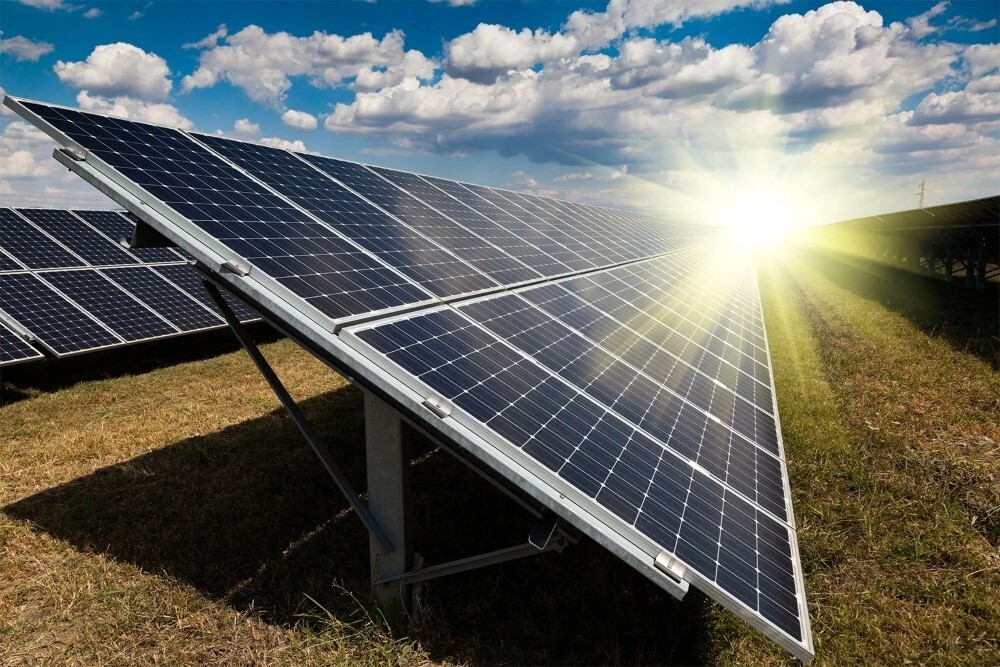

India’s renewable energy landscape is poised for a significant turnaround with three major solar project announcements from Adani Green Energy, Jindal India Thermal Power and Alpex Solar. These developments come at a critical juncture, as the country witnessed a notable 25 per cent drop in new solar capacity additions in the first quarter of 2025.

Image source: britannica
India added just 6.7 gigawatts of solar capacity in Q1 2025, down from 9 gigawatts during the same period in 2024. The decline was attributed to delayed project commissioning, supply chain bottlenecks and cautious investor sentiment. However, recent announcements in the sector signal a revival in momentum that could help bridge this capacity gap in the coming months.
Adani Green Energy Ltd (AGEL) has commissioned 187.5 MW of additional solar power capacity at Khavda, Gujarat, raising AGEL’s total operational renewable energy capacity to 14,528.4 MW. The company plans to commission 5 GW more in FY26, with 95 per cent of this already sanctioned and financed. CFO Saurabh Shah confirmed that debt arrangements are in place and no financial challenges are anticipated. CEO Ashish Khanna addressed concerns over the current 27 per cent wind CUF, attributing it to seasonal variations and legacy assets. However, with the deployment of India’s largest 5.2 MW wind turbines at Khavda, CUF performance is expected to improve.
Looking ahead, AGEL aims to add 4 GW of renewable energy capacity by June 2025 and 7 GW by the year-end. Khanna highlighted that solar CUF is largely dependent on irradiation, and the company has already observed CUFs exceeding 32 per cent in the current quarter. The leadership expressed optimism that technological upgrades and favourable weather patterns will continue to drive efficiency and growth across AGEL’s clean energy portfolio.
In parallel, BC Jindal Group’s renewable arm, Jindal India Renewable Energy (JIRE), has secured a 300 MW solar-plus-storage project from state-run SJVN. This is part of SJVN’s 1,200 MW ISTS-connected solar tender, which includes 600 MW/2,400 MWh of battery energy storage systems (BESS). Awarded on a build-own-operate basis, JIRE will supply power at a tariff of Rs 3.32/kWh for 25 years, with delivery to state utilities. The project must be commissioned within 24 months of signing the PPA, and includes a mandatory 0.5 MW/2 MWh BESS per 1 MW of solar capacity. This follows JIRE’s recent win of a similar 300 MW solar-plus-storage project from NHPC, reinforcing its foothold in the utility-scale renewables sector.
JIRE is set to invest USD 2.5 billion (approx. Rs 208 billion) in clean energy over the next five years, targeting a total capacity of 5 GW across solar, wind, hybrid, round-the-clock (RTC), and firm and dispatchable renewable energy (FDRE) platforms. Additionally, it is establishing a 2 GW solar cell and module manufacturing facility in Maharashtra, scheduled to be operational by September 2026. The company’s growth strategy focuses on expanding its nationwide asset base through a mix of internal accruals and debt. With battery energy storage playing a critical role in grid stability and reliable power supply, the sector is expected to grow at a CAGR of 11.41 per cent through 2032, supporting India’s broader energy transition goals.
Greater Noida-based Alpex Solar has announced the acquisition of contracts worth ₹10.7 billion (USD 128.9 million) from several major organisations, including the Central Mine Planning and Design Institute Ltd (CMPDIL) and the Haryana Renewable Energy Development Agency. In partnership with NVNR Power & Infra Ltd, Alpex will execute a ₹3.5 billion (USD 42.17 million) project for CMPDIL involving the design, engineering, procurement and commissioning of a grid-connected solar power plant at Nandan Washery, Maharashtra. Holding a 70 per cent stake in the consortium, Alpex will also be responsible for constructing a 32kV double-circuit transmission line along with bay extension works.
These high-value projects are also closely tied to the aluminium industry’s growing influence in India’s clean energy transition. The aluminium sector in India could contribute up to 20 GW of solar and wind power capacity by 2030. Besides, aluminium is increasingly being used in solar module frames, mounting structures, and electrical components due to its lightweight, corrosion-resistant and highly recyclable properties.
For companies like Adani, Jindal and Alpex, the use of aluminium not only improves the durability and cost-efficiency of installations but also contributes to the broader goal of decarbonisation and supply chain sustainability. As the Indian government and private sector push towards energy security and climate commitments, aluminium will continue to play a crucial enabling role.
Responses








